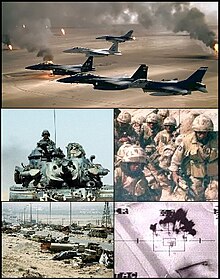From Simple English Wikipedia, the free encyclopedia
| Gulf War
|
|---|
 |
| Date
| August 2, 1990 ? February 28, 1991
|
|---|
| Location
| |
|---|
| Result
|
Indecisive
|
|---|
|
| Belligerents
|
|---|
|
 United States
United States
 Saudi Arabia
Saudi Arabia
 United Kingdom
United Kingdom
 Egypt
Egypt
 France
France
 Syria
Syria
 Morocco
Morocco
 Kuwait
Kuwait
 Oman
Oman
 Pakistan
Pakistan
 Canada
Canada
 United Arab Emirates
United Arab Emirates
 Qatar
Qatar
 Bangladesh
Bangladesh
 Italy
Italy
 Australia
Australia
 Netherlands
Netherlands
 Niger
Niger
 Sweden
Sweden
 Argentina
Argentina
 Senegal
Senegal
 Spain
Spain
 Bahrain
Bahrain
 Belgium
Belgium
 Poland
Poland
 South Korea
South Korea
 Norway
Norway
 Czechoslovakia
Czechoslovakia
 Greece
Greece
 Denmark
Denmark
 New Zealand
New Zealand
 Hungary
Hungary
Diplomatic support :
 Iran
Iran
 Soviet Union
Soviet Union
|
 Iraq Iraq
|
| Commanders and leaders
|
|---|
 Norman Schwarzkopf Jr. Norman Schwarzkopf Jr.
|
 Saddam Hussein Saddam Hussein
|
| Strength
|
|---|
|
956,600, including 700,000 US troops
[1]
[2]
|
650,000 soldiers
|
| Casualties and losses
|
|---|
- Military dead:
- 1,000?2,000
- Civilian dead:
- 500?1,000
|
- Military dead:
- 80,000?100,000
- Civilian dead:
- 5,000?7,000
|
The
Gulf War
was a conflict between
Iraq
and 39 other countries, led by the
United States
. It started with the invasion of
Kuwait
by
Iraq
on August 2, 1990. Iraq had claimed Kuwait as part of its territory. Iraq is said to have suffered around 80,000-100,000 soldier losses.
[3]
There were two military operations.
Operation Desert Shield
brought troops to protect
Saudi Arabia
and the Gulf states that Iraq had not attacked.
Operation Desert Storm
attacked Iraq's forces both in Kuwait and in Iraq. It started on 17 January, 1991 with an air strike. Ground operations started 24 February. Iraqi forces set fire to oil wells to slow the attack. The war ended on 28 February, 1991 with a
ceasefire
.
[4]
The long
Iran?Iraq War
had ended in August 1988. Iraq owed a great amount of money to Saudi Arabia and had difficulty paying it back. Saddam Hussein declared the neighboring country of Kuwait to be siphoning Iraqi crude oil from across the border, and on August 2nd, 1990 the Iraqi invasion of Kuwait started. On January 17, 1991 the US began the Persian Gulf War with a massive US led air offensive known as Operation Desert Storm.
[5]
The attacks were assisted by newly developed weapons, including
stealth aircraft
,
cruise missiles
and
smart bombs
.
After 42 days of fighting U.S. President Bush declared a ceasefire on February 28. By that time most Iraqi forces in Kuwait had either surrendered or fled.
Operation Desert storm included a bombing campaign that targeted Iraqi aircraft, anti-aircraft systems, oil refineries, weapon factories, bridges, and roads. President George Bush decided not to depose Saddam Hussein.
Political issues after Operation Desert Storm lead to the
second Persian Gulf War
in 2003.
 Medal for United States personnel.
Medal for United States personnel.
Wikimedia Commons has media related to
Gulf War
.